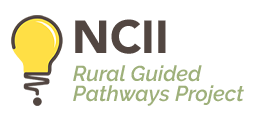Rural Pathways provides a deliberate venue for rural college practitioners to collaborate while they work to improve student outcomes. Historically, rural community college leaders have not had many opportunities to problem-solve around the student success and completion issues that are particular to their culture, context, and capacity. Some rural colleges have participated in national reform efforts such as AACC’s Guided Pathways Projects and Achieving the Dream, but they often struggle to apply strategies — even those that work well at urban and suburban institutions — in their rural context.
While rural leaders at all levels of colleges often create de-facto partnerships with colleagues to work through issues, these tend to be unsupported, uncoordinated one-off collaborations; colleges do not have mechanisms to share what they learn more broadly with their peers at other rural institutions. Rural Pathways gives rural colleges opportunities to work through challenging issues and collaborate with peer institutions, all in the context of a learning community that provides a broad range of supports.
Guided pathways, as an implementation framework, has proven to be the most successful structure to help colleges plan and implement radical changes to the student experience at scale. Rural Pathways approaches guided pathways through the lens of improving the student experience. Participating institutions are learning how to implement the essential practices in the four pillars of the guided pathways framework using an integrated, cross-functional approach and involving community partners. Colleges are focusing on how students engage with and move through their institutions. Further, colleges are rethinking their current structures so they approach this work in an integrated way that breaks down internal silos. Colleges are focusing on increasing completion rates, improving post-college outcomes, and ensuring that their programs prepare students for employment and further education in fields that expand their economic opportunity and meet local workforce needs.
